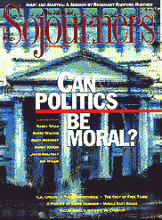It's my party, and I'll cry if I want to..."so goes a popular song of several years ago.
Every presidential election I realize that I, like many Americans, feel like I don't have a party...and it discourages me. For many in this country, such disillusionment means abstinence from the voting booth. It hasn't meant that for me; but I sure understand the feeling.
This month I look at several books and a film that examine the alienation of American Voters.
At Stake: Democracy
Several new books provide much-needed in-depth coverage and analysis of the power and influence of public relations firms and image-makers. These figures, and the organizations they represent, pose a dangerous threat to democracy.
Investigative journalist Bill Greider offers a frank analysis of the state of American democracy in Who Will Tell the People: The Betrayal of American Democracy (Simon & Schuster, 1992, $25, cloth). Examining the sense of betrayal many Americans feel, the disintegration of mediating institutions, and the obvious decay of people's confidence, Greider forecasts bleak circumstances. But this is not simply the work of a naysayer; it is a book by someone who obviously believes in the possibilities of the American system without defending naively all its activities.
Greider issues a challenge to those who are working to empower people. It cannot be done by trying to match the power of the elite; media-oriented shock tactics are too short-term in their effects. Only the hard work of citizen organizing and information sharing will truly confront the power structures in this image age.
The heart of this book became a Frontline PBS special ("The Betrayal of Democracy"), giving his message another medium for expression and forum for change. Greider's insights may be just the analysis we need to alter the impending future.
Read the Full Article

